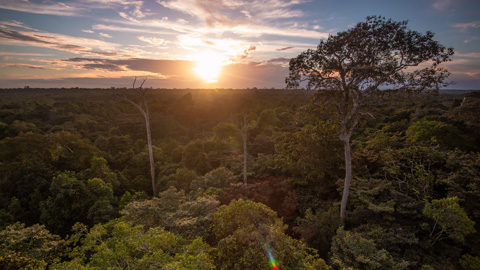Bolivian Amazon on road to deforestation

09/01/2018
In August 2017, the Bolivian government passed a contentious law that paved the way for construction of a new 190-mile road cutting through one of the country’s most iconic and biodiverse protected rainforests. But a report in Current Biology on January 8th shows that the Isiboro-Sécure National Park and Indigenous Territory (or TIPNIS, as the area is commonly known) has been subject to alarming levels of deforestation within its borders for many years, a reality that is too often overlooked.
TIPNIS, which is also the ancestral homeland of four lowland indigenous groups, lost more than 46,000 hectares of forest from 2000 to 2014, according to a new report conducted by the researchers Álvaro Fernández-Llamazares and Vitoria Reyes-Garcia from the Institute of Environmental Science and Technology of the Universitat Autònoma de Barcelona in collaboration with scientist from the University of Helsinki, the Bolivia’s Universidad Mayor de San Andrés and the University of Cambridge. The researchers say they hope the findings will help to give public debate on the matter a stronger foundation based on the best knowledge available.
“While many discuss the potential impacts that the planned road could have in the future, very little is spoken about current ecological impacts in the area,” said Álvaro Fernández-Llamazares associated researcher at ICTA-UAB and researcher at the University of Helsinki. “Our analyses show that TIPNIS is already facing rampant levels of deforestation.”
It is well established that roads in tropical forests frequently lead to additional habitat conversion. In the case of TIPNIS, the researchers including Mónica Moraes at Bolivia’s Universidad Mayor de San Andrés report that more than 58 percent of deforestation is found within five kilometres of existing roads. This trend suggests that the planned road will only “magnify the current scale and pace of deforestation in TIPNIS.”
“We were surprised to discover that one of Bolivia’s most iconic national parks could be facing such alarming levels of deforestation,” Moraes said. That TIPNIS has lost more than 46,000 hectares of forest since the year 2000 “is simply unbelievable, considering that the park is not only one of the main biodiversity hotspots in Bolivia, but also one of the most biodiverse regions on Earth.”
She noted the area harbours many plant species that do not live anywhere else. It is also home to emblematic wildlife species, such as the jaguar, marsh deer, and giant otter.
While food security is often noted as justification for roads in the Tropics, the researchers add that most of the deforestation to date in TIPNIS is associated with coca cultivation, not food crops. With expanded coca cultivation and new incentives for oil and gas exploration throughout Bolivia, they say downgrading the legal protection of TIPNIS will likely spur even greater biodiversity losses. The authors call on Bolivia’s Government to revisit the road plans. “Bolivian delegations have been very active in climate change negotiations and have vehemently advocated for the codification of the rights of Mother Earth in several international policy frameworks,” Fernández-Llamazares said. “The road would most likely open a Pandora’s box of environmental problems that, as a signatory of the Convention on Biological Diversity, Bolivia cannot afford.”